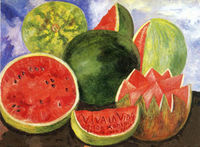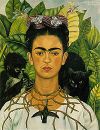User:Zana Dark/Frida Kahlo

Pop-culture icon and lesbian role-model Frida Kahlo was an international painter known for her (yes, it's a her) ability to illustrate mustaches and unibrows in disturbingly accurate detail. Frida's life wasn't an easy one, but she made the most of it. One of the most recognized artists of all time, her art, like her facial hair, is complex, fascinating and inspiring. This is her story.
The Early Years[edit | edit source]
Frida 'Caliente' Kahlo was born July 6, 1907 near Mexico City. She was a tomboy at school (not in any way related to the fact that she already had a Fu Manchu at age six) and the leader of a group of rebellious, mostly male youngsters who became known for pulling tons of pranks and practical jokes. That's when the fun really begins for Frida.
When Frida turned 18, she contracted Polio and had to spend nine months confined to her bed. Just towards the end of that time the ambulance she was riding in collided with a streetcar, but Kahlo escapes with only a broken spinal column, collarbone, several ribs, a shattered pelvis, eleven fractures in her right leg, a crushed and dismembered right foot, and a dislocated shoulder. Additionally, an iron handrail impaled her abdomen, piercing her uterus and rendering her incapable of reproduction. Plus, her right leg had to be amputated below the knee due to a gangrene infection. But the illness, and accident, and impalement, and infertility, and amputation only made Frida more determined than ever to live life to the fullest. I mean, it was during her long recovery from these events that Kahlo discovered her love of painting. This was however, after failure at trying javelin, horseback riding, sculpting, archery, uncyclopedia editing and stamp collecting.
After her recovery, Frida started hanging out with a group of Mexican artists who introduced her to the well-known Mexican muralist, Diego Rivera, the then most famous artist in Mexico. Frida Kahlo set her sights on marrying Diego Rivera, some 20 years her senior, some 200 pounds her heavier, with the tenacity of an ovulating groupie. Although disgusted by her facial hair, Rivera immediately recognized her talent and encouraged her to continue painting.
The Artist[edit | edit source]
Were her paintings any good? Would we be watching biopics and reading stupid little Uncyclopedia articles if she hadn't been married to Diego Rivera? Depends on who you ask.
Upon further examination of some books of her paintings and writings, you may reach the conclusion that Frida Kahlo is one of the most overrated artists of all-time. She was a psychotically self-obsessed, whorish woman with poor technical skill. Her paintings obsessed over lame symbols of motherhood, death and rebirth; blood and roses, and she simply 'borrowed' from surrealistic and neo-primitive art to cover up her own lack of imagination. Her writings prove her to be maniacal, mentally disturbed and sub-literate. An avid Communist, she painted loving portraits of Stalin and Mao. How strange for an icon of feminism to be so subservient of racist, mysogynistic, tyrannical and murderous men! How lovingly Frida would gaze upon Sudam Hussein, a dictator with an atrocious human rights record who advocates the enslavement of women, all with a mustached smile (Frida, not Sudam).
Despite these facts, however, Frida had her followers. There's a great element of daring in her work; she revealed so much of her physical and emotional pain, so much of herself, in her paintings. She put a lot out there. They're also painted in a way that's very engaging to people. She uses a combination of realism and magic, reality and fantasy that comes together in a very visually compelling way. Legendary pop music icon Madonna collects Frida's paintings in a manner that has described as 'disturbing' and 'grotesque'. So much so that the media hotly questions whether Madonna's children should be allowed to view the collection, let alone Madonna's own work.
But back to Kahlo:
The Legacy[edit | edit source]
Peeps from all over the world loved Kahlo and her art. During her life she had three exhibitions - one in New York, one in Paris, and the last one in Mexico City, where a nubile Frida bounded around, frolicking amongst her many adoring fans.
At the ripe-old age of 47, Frida Kahlo died. Although she was happy, by that time Frida was senile, and even though at the time no one ever officially declared the cause, officials suspected it was death by laughter. Frida had led such a long, happy life, and the last entry in Kahlo's diary read, "I hope (that dying) is as joyful and hilarious as my big-screen debut."





